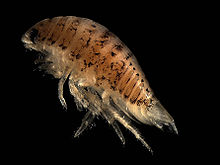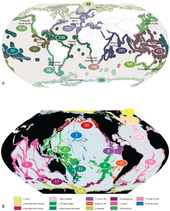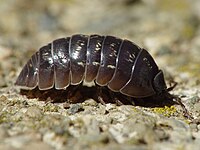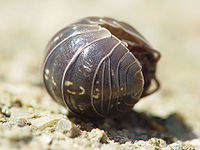Isopoda
| Isopoda | |
|---|---|

| |
| Eurydice pulchra, a carnivorous isopod found on sandy shores | |
| Scientific classification | |
| Domain: | Eukaryota |
| Kingdom: | Animalia |
| Phylum: | Arthropoda |
| Class: | Malacostraca |
| Superorder: | Peracarida |
| Order: | Isopoda Latreille, 1817 [1] |
| Suborders | |
| |
Isopoda is an order of crustacean, which includes woodlice and their relatives. Members of this group are called Isopods and include both terrestrial and aquatic species. All have rigid, segmented exoskeletons, two pairs of antennae, seven pairs of jointed limbs on the thorax, and five pairs of branching appendages on the abdomen that are used in respiration. Females brood their young in a pouch under their thorax.
Isopods have various feeding methods: some eat dead or decaying plant and animal matter, others are
There are over 10,000 identified species of isopod worldwide, with around 4,500 species found in marine environments, mostly on the seabed, 500 species in fresh water, and another 5,000 species on land. The order is divided into eleven suborders. The fossil record of isopods dates back to the Carboniferous period (in the Pennsylvanian epoch), at least 300 million years ago, when isopods lived in shallow seas. The name Isopoda is derived from the Greek roots iso- (from ἴσος ísos, meaning "equal") and -pod (from ποδ-, the stem of πούς poús, meaning "foot").[2][3]
Description

showing the head with eyes and antennae, carapace and relatively uniform limbs
Classified within the
The seven free segments of the thorax each bear a pair of unbranched pereopods (limbs). In most species these are used for locomotion and are of much the same size,
One or more of the abdominal segments, starting with the sixth segment, is fused to the
Diversity and classification


Isopods belong to the larger group
Some isopod groups have evolved a
The World Marine, Freshwater and Terrestrial Isopod Crustaceans database subdivides the order into eleven suborders:[1]
- Asellota – This suborder contains the superfamily Aselloidea, a group that contains most of the freshwater isopods in the northern hemisphere, and the superfamilies Stenetrioidea, Gnathostenetroidoidea and Janiroidea, which are mostly marine. The latter superfamily, Janiroidea, has a massive radiation of deepsea families, many of which have taken bizarre forms.
- Calabozoida – A small suborder consisting of two marine species in the family Calabozoidae and one freshwater species in the family Brasileirinidae which is found in subterranean locations.[18]
- Cymothoida – Chiefly marine isopods[9] with over 2,700 species. Members are mostly carnivorous or parasitic. Includes the family Gnathiidae, the juveniles of which are parasitic on fishes.[19] The previously recognised suborder Epicaridea is included as two superfamilies within this suborder and Cymothoida now includes part of the formerly recognised suborder Flabellifera.[20] Also includes the former suborder Anthuridea, a group of worm-like isopods with very long bodies.
- Limnoriidea – Mainly tropical isopods, some of which are herbivorous.[20]
- Microcerberidea – Tiny, worm-like isopods that live between particles on the bed of freshwater and shallow marine habitats.[9]
- Oniscidea – Semi-terrestrial and terrestrial isopods fully adapted for life on land.[9] There are over 4,000 species of woodlice inhabiting forests, mountains, deserts and the littoral zone.[21]
- Phoratopus remex, which warrants its own suborder because of its unique characteristics.[20]
- amphipods, limited to South Africa, India, Australia and New Zealand.[9]
- Sphaeromatidea – Benthic isopods mostly from the southern hemisphere with respiratory pleopods inside a branchial chamber. This suborder now includes part of the formerly recognised suborder Flabellifera.[20][22]
- Tainisopidea – Freshwater isopods in a "relictual environment".[20]
- Valvifera – A large group of benthic, marine isopods with respiratory pleopods inside a branchial chamber under the abdomen.[9]
Evolutionary history
Isopods first appeared in the
The short-tailed isopods have a short pleotelson and terminal, stylus-like uropods and have a sedentary lifestyle on or under the sediment on the seabed. The long-tailed isopods have a long pleotelson and broad lateral uropods which can be used in swimming. They are much more active and can launch themselves off the seabed and swim for short distances. The more advanced long-tailed isopods are mostly endemic to the southern hemisphere and may have radiated on the ancient supercontinent of Gondwana soon after it broke away from Laurasia 200 million years ago. The short-tailed forms may have been driven from the shallow seas in which they lived by increased predatory pressure from marine fish, their main predators. The development of the long-tailed forms may also have provided competition that helped force the short-tailed forms into refugia. The latter are now restricted to environments such as the deep sea, freshwater, groundwater and dry land. Isopods in the suborder Asellota are by far the most species-rich group of deep sea isopods.[14]
Locomotion
Unlike the amphipods, marine and freshwater isopods are entirely benthic. This gives them little chance to disperse to new regions and may explain why so many species are endemic to restricted ranges. Crawling is the primary means of locomotion, and some species bore into the seabed, the ground or timber structures. Some members of the families Sphaeromatidae, Idoteidae and Munnopsidae are able to swim pretty well, and have their front three pairs of pleopods modified for this purpose, with their respiratory structures limited to the hind pleopods. Most terrestrial species are slow-moving and conceal themselves under objects or hide in crevices or under bark. The semi-terrestrial sea slaters (Ligia spp.) can run rapidly on land and many terrestrial species can roll themselves into a ball when threatened, a feature that has evolved independently in different groups and also in the marine sphaeromatids.[9][24][25]
Feeding and nutrition

Isopods have a simple gut which lacks a midgut section; instead there are
Isopods are
Parasitic species are mostly external parasites of fish or crustaceans and feed on blood. The larvae of the Gnathiidae family and adult cymothoidids have piercing and sucking mouthparts and clawed limbs adapted for clinging onto their hosts. In general, isopod parasites have diverse lifestyles and include Cancricepon elegans, found in the gill chambers of crabs; Athelges tenuicaudis, attached to the abdomen of hermit crabs; Crinoniscus equitans living inside the barnacle Balanus perforatus; cyproniscids, living inside ostracods and free-living isopods; bopyrids, living in the gill chambers or on the carapace of shrimps and crabs and causing a characteristic bulge which is even recognisable in some fossil crustaceans; and entoniscidae living inside some species of crab and shrimp.[9][28] Cymothoa exigua is a parasite of the spotted rose snapper Lutjanus guttatus in the Gulf of California; it causes the tongue of the fish to atrophy and takes its place in what is believed to be the first instance discovered of a parasite functionally replacing a host structure in animals.[29]
Reproduction and development
In most species, the sexes are separate and there is little sexual dimorphism, but a few species are hermaphroditic and some parasitic forms show large differences between the sexes.[9] Some Cymothoidans are protandrous hermaphrodites, starting life as males and later changing sex, and some Anthuroideans are the reverse, being protogynous hermaphrodites that are born female. Some Gnathiidans males are sessile and live with a group of females.[26] Males have a pair of penises, which may be fused in some species. The sperm is transferred to the female by the modified second pleopod which receives it from the penis and which is then inserted into a female gonopore. The sperm is stored in a special receptacle, a swelling on the oviduct close to the gonopore. Fertilisation only takes place when the eggs are shed soon after a moult, at which time a connection is established between the semen receptacle and the oviduct.[9]
The eggs, which may number up to several hundred, are brooded by the female in the marsupium, a chamber formed by flat plates known as oostegites under the thorax. This is filled with water even in terrestrial species.[9] The eggs hatch as mancae, a post-larval stage which resembles the adult except for the absence of the last pair of pereopods. The lack of a swimming phase in the life cycle is a limiting factor in isopod dispersal, and may be responsible for the high levels of endemism in the order.[14] As adults, isopods differ from other crustaceans in that moulting occurs in two stages known as "biphasic moulting".[3] First they shed the exoskeleton from the posterior part of their body and later shed the anterior part. The giant Antarctic isopod Glyptonotus antarcticus is an exception, and moults in a single process.[30]
Terrestrial isopods
The majority of crustaceans are aquatic and the isopods are one of the few groups of which some members now live on land.
The woodlice, suborder
Many species can roll themselves into a ball, a behaviour used in defence that also conserves moisture. Members of the families Ligiidae and Tylidae, commonly known as rock lice or sea slaters, are the least specialised of the woodlice for life on land. They inhabit the splash zone on rocky shores, jetties and pilings, may hide under debris washed up on the shore and can swim if immersed in water.[9]
References
- ^ a b "Isopoda". WoRMS. World Register of Marine Species. 2014. Retrieved 8 May 2014.
- ^ "Isopod". Merriam-Webster. Encyclopædia Britannica. Retrieved 27 June 2014.
- ^ a b c d e f g Schotte, M.; Boyko, C. B.; Bruce, N. L.; Markham, J.; Poore, G. C. B.; Taiti, S.; Wilson, G. D. F. "World List of Marine, Freshwater and Terrestrial Isopod Crustaceans". World Register of Marine Species. Retrieved 4 June 2014.
- ISBN 978-0-226-84548-7.
- ^ ISBN 978-0-12-515150-4.
- ^ "Isopod, Pillbug, Sow Bug Information". University of Arizona. 1997. Archived from the original on 23 September 2014. Retrieved 21 August 2014.
- JSTOR 1935640.
- ^ Keable, S. J.; Poore, G. C. B.; Wilson, G. D. F. (2 October 2002). "Australian Isopoda: Families". Australian Museum. Archived from the original on 10 October 2018. Retrieved 5 June 2014.
- ^ ISBN 978-81-315-0104-7.)
{{cite book}}: CS1 maint: multiple names: authors list (link - ^ Wilson, G. D. F. (1989). "A systematic revision of the deep-sea subfamily Lipomerinae of the isopod crustacean family Munnopsidae". Bulletin of the Scripps Institution of Oceanography. 27: 1–138.
- .
- ISBN 978-0-231-06880-2.
- ^ Martin, Joel W.; Davis, George E. (2001). An Updated Classification of the Recent Crustacea (PDF). Natural History Museum of Los Angeles County. p. 132. Archived from the original (PDF) on 12 May 2013. Retrieved 14 December 2009.
- ^ a b c d e Brusca, Richard (6 August 1997). "Isopoda". Tree of Life Web Project. Retrieved 5 June 2014.
- ^ Williams, Ernest H. Jr. (2000). Keynote Address: Isopods as parasites or associates of fishes. Parasitology 2000: One Eye on the Future, One Eye on the Past. Southeastern Society of Parasitologists. pp. 9–10.
- PMID 21966129.
- ^ Shimek, Ronald L. (2002). "Pills, parasites, and predators; isopods in the reef aquarium". Reefkeeping. Vol. 1, no. 4.
- ^ "Calabozoidea". WoRMS. World Register of Marine Species. 2014. Retrieved 5 June 2014.
- ^ Srour, Marc (13 July 2012). "Tongue Biters and Deep Sea Giants: The Cymothoida (Crustacea: Isopoda)". Teaching Biology. Archived from the original on 6 June 2014. Retrieved 8 May 2014.
- ^ doi:10.1071/IS02032.
- ^ Brusca, Richard; Coelho, Vania R.; Taiti, Stefano (2001). "Suborder Oniscidea (Terrestrial Isopods)". Tree of Life Web Project. Retrieved 8 May 2014.
- ^ "Flabellifera". WoRMS. World Register of Marine Species. 2014. Retrieved 12 June 2014.
- S2CID 31851291.
- ^ Proceedings of the United States National Museum
- ^ Diversity and distribution of the deep-sea Atlantic Acanthocope (Crustacea, Isopoda, Munnopsidae), with description of two new species
- ^ PMID 22952700.
- ^ )
- ^ Shields, Jeffrey. "Epicaridea: The parasitic isopods of Crustacea". Virginia Institute of Marine Science. Retrieved 23 March 2014.
- JSTOR 1444352.
- .
- ^ S2CID 17595540.
- ^ "Benthic animals". Icelandic Ministry of Fisheries and Agriculture. Archived from the original on 11 May 2014. Retrieved 4 June 2014.
- S2CID 42144479.
- PMID 21735203.
External links
 Media related to Isopoda at Wikimedia Commons
Media related to Isopoda at Wikimedia Commons Data related to Isopoda at Wikispecies
Data related to Isopoda at Wikispecies- World List of Marine Freshwater and Terrestrial Isopod Crustaceans


